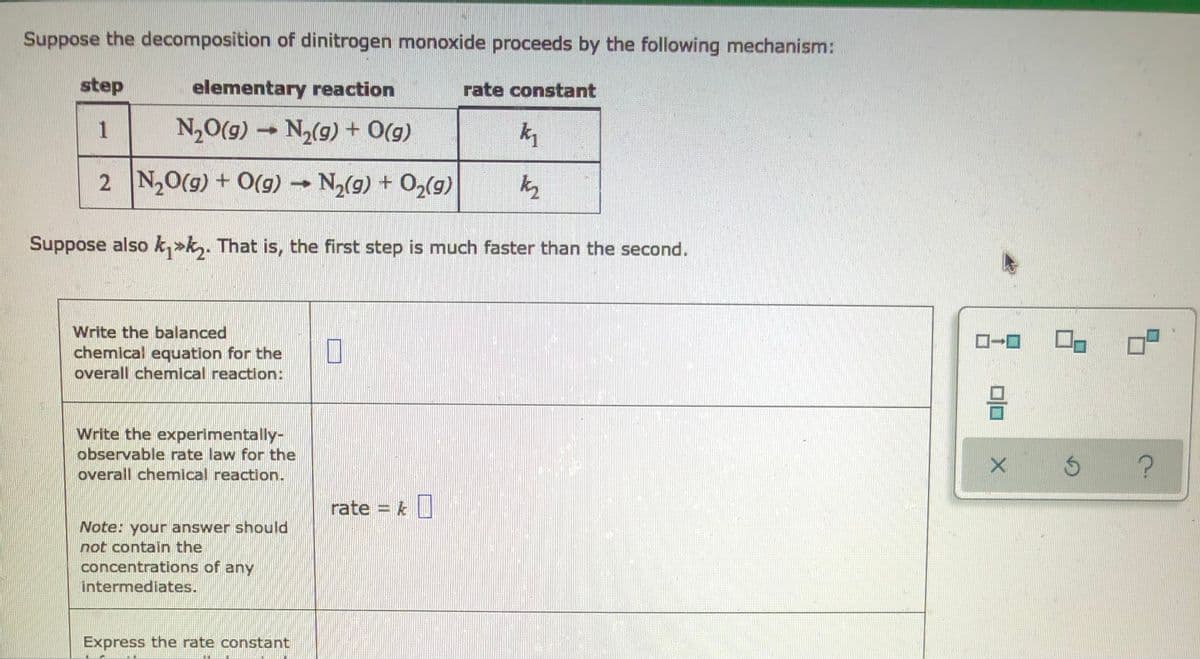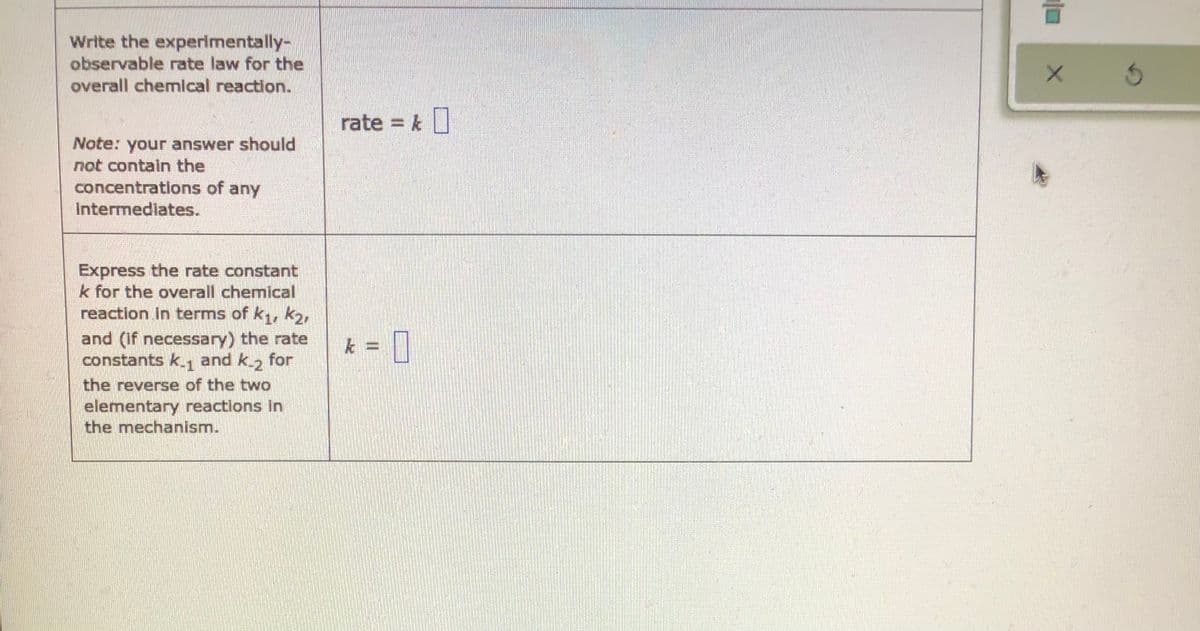Suppose the decomposition of dinitrogen monoxide proceeds by the following mechanism: step elementary reaction rate constant N,0(g) N2(g) + O(g) 2 N20(9) + O(9) N2(g) + O2(g) Suppose also k,»k. That is, the first step is much faster than the second. Write the balanced chemical equation for the overall chemical reaction: Write the experimentally- observable rate law for the overall chemical reaction. rate = k| Note: your answer should not contain the concentrations of any intermediates. Express the rate constant
Suppose the decomposition of dinitrogen monoxide proceeds by the following mechanism: step elementary reaction rate constant N,0(g) N2(g) + O(g) 2 N20(9) + O(9) N2(g) + O2(g) Suppose also k,»k. That is, the first step is much faster than the second. Write the balanced chemical equation for the overall chemical reaction: Write the experimentally- observable rate law for the overall chemical reaction. rate = k| Note: your answer should not contain the concentrations of any intermediates. Express the rate constant
Chemistry: Principles and Practice
3rd Edition
ISBN:9780534420123
Author:Daniel L. Reger, Scott R. Goode, David W. Ball, Edward Mercer
Publisher:Daniel L. Reger, Scott R. Goode, David W. Ball, Edward Mercer
Chapter13: Chemical Kinetics
Section: Chapter Questions
Problem 13.67QE
Related questions
Question

Transcribed Image Text:Suppose the decomposition of dinitrogen monoxide proceeds by the following mechanism:
step
elementary reaction
rate constant
1
N,O(g) –
N2(g) + 0(g)
2 N,0(g) + O(g) N,(g) + O2(g)
Suppose also k,>k,. That is, the first step is much faster than the second.
Write the balanced
chemical equation for the
overall chemical reaction:
Write the experimentally-
observable rate law for the
overall chemical reaction.
rate = k|
Note: your answer should
not contain the
concentrations of any
intermediates.
Express the rate constant

Transcribed Image Text:Write the experlmentally-
observable rate law for the
overall chemical reaction.
rate = k
Note: your answer should
not contain the
concentrations of any
Intermediates.
Express the rate constant
k for the overall chemical
reaction in terms of k1, k2,
and (If necessary) the rate
constants k. and k.2 for
k =
the reverse of the two
elementary reactions in
the mechanism.
Expert Solution
This question has been solved!
Explore an expertly crafted, step-by-step solution for a thorough understanding of key concepts.
This is a popular solution!
Trending now
This is a popular solution!
Step by step
Solved in 3 steps with 1 images

Knowledge Booster
Learn more about
Need a deep-dive on the concept behind this application? Look no further. Learn more about this topic, chemistry and related others by exploring similar questions and additional content below.Recommended textbooks for you

Chemistry: Principles and Practice
Chemistry
ISBN:
9780534420123
Author:
Daniel L. Reger, Scott R. Goode, David W. Ball, Edward Mercer
Publisher:
Cengage Learning

Chemistry by OpenStax (2015-05-04)
Chemistry
ISBN:
9781938168390
Author:
Klaus Theopold, Richard H Langley, Paul Flowers, William R. Robinson, Mark Blaser
Publisher:
OpenStax

Chemistry for Engineering Students
Chemistry
ISBN:
9781337398909
Author:
Lawrence S. Brown, Tom Holme
Publisher:
Cengage Learning

Chemistry: Principles and Practice
Chemistry
ISBN:
9780534420123
Author:
Daniel L. Reger, Scott R. Goode, David W. Ball, Edward Mercer
Publisher:
Cengage Learning

Chemistry by OpenStax (2015-05-04)
Chemistry
ISBN:
9781938168390
Author:
Klaus Theopold, Richard H Langley, Paul Flowers, William R. Robinson, Mark Blaser
Publisher:
OpenStax

Chemistry for Engineering Students
Chemistry
ISBN:
9781337398909
Author:
Lawrence S. Brown, Tom Holme
Publisher:
Cengage Learning

Principles of Modern Chemistry
Chemistry
ISBN:
9781305079113
Author:
David W. Oxtoby, H. Pat Gillis, Laurie J. Butler
Publisher:
Cengage Learning

Chemistry: Principles and Reactions
Chemistry
ISBN:
9781305079373
Author:
William L. Masterton, Cecile N. Hurley
Publisher:
Cengage Learning
